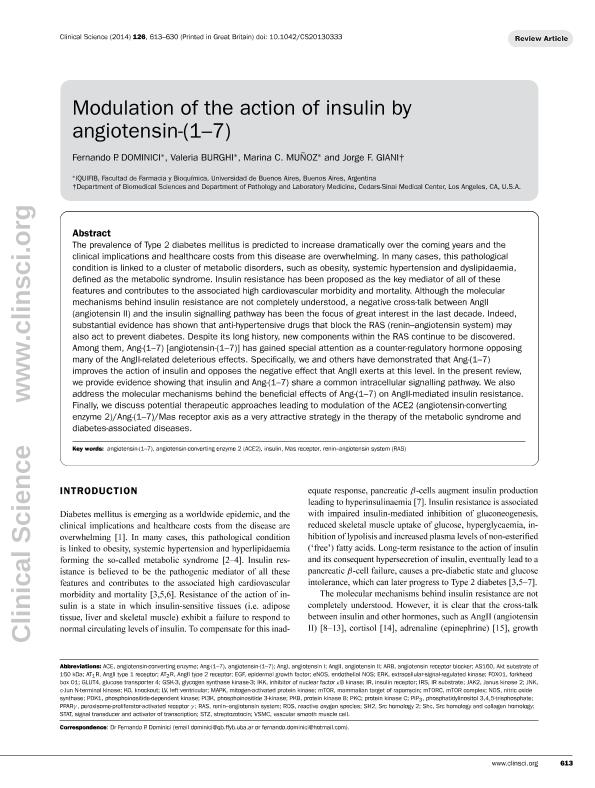Mostrar el registro sencillo del ítem
dc.contributor.author
Dominici, Fernando Pablo

dc.contributor.author
Burghi, Valeria

dc.contributor.author
Muñoz, Marina Cecilia

dc.contributor.author
Giani, Jorge Fernando

dc.date.available
2017-06-12T21:23:21Z
dc.date.issued
2014-05
dc.identifier.citation
Dominici, Fernando Pablo; Burghi, Valeria; Muñoz, Marina Cecilia; Giani, Jorge Fernando; Modulation of the action of insulin by angiotensin-(1-7); Portland Press; Clinical Science; 126; 9; 5-2014; 613-630
dc.identifier.issn
0143-5221
dc.identifier.uri
http://hdl.handle.net/11336/18058
dc.description.abstract
The prevalence of Type 2 diabetes mellitus is predicted to increase dramatically over the coming years and the clinical implications and healthcare costs from this disease are overwhelming. In many cases, this pathological condition is linked to a cluster of metabolic disorders, such as obesity, systemic hypertension and dyslipidaemia, defined as the metabolic syndrome. Insulin resistance has been proposed as the key mediator of all of these features and contributes to the associated high cardiovascular morbidity and mortality. Although the molecular mechanisms behind insulin resistance are not completely understood, a negative cross-talk between AngII (angiotensin II) and the insulin signalling pathway has been the focus of great interest in the last decade. Indeed, substantial evidence has shown that anti-hypertensive drugs that block the RAS (renin–angiotensin system) may also act to prevent diabetes. Despite its long history, new components within the RAS continue to be discovered. Among them, Ang-(1–7) [angiotensin-(1–7)] has gained special attention as a counter-regulatory hormone opposing many of the AngII-related deleterious effects. Specifically, we and others have demonstrated that Ang-(1–7) improves the action of insulin and opposes the negative effect that AngII exerts at this level. In the present review, we provide evidence showing that insulin and Ang-(1–7) share a common intracellular signalling pathway. We also address the molecular mechanisms behind the beneficial effects of Ang-(1–7) on AngII-mediated insulin resistance. Finally, we discuss potential therapeutic approaches leading to modulation of the ACE2 (angiotensin-converting enzyme 2)/Ang-(1–7)/Mas receptor axis as a very attractive strategy in the therapy of the metabolic syndrome and diabetes-associated diseases.
dc.format
application/pdf
dc.language.iso
eng
dc.publisher
Portland Press

dc.rights
info:eu-repo/semantics/openAccess
dc.rights.uri
https://creativecommons.org/licenses/by-nc-sa/2.5/ar/
dc.subject
Angiotensin-(1–7)
dc.subject
Insulin
dc.subject
Mas Receptor
dc.subject
Renin–Angiotensin System (Ras)
dc.subject
Angiotensin-Converting Enzyme 2 (Ace2
dc.subject.classification
Bioquímica y Biología Molecular

dc.subject.classification
Ciencias Biológicas

dc.subject.classification
CIENCIAS NATURALES Y EXACTAS

dc.title
Modulation of the action of insulin by angiotensin-(1-7)
dc.type
info:eu-repo/semantics/article
dc.type
info:ar-repo/semantics/artículo
dc.type
info:eu-repo/semantics/publishedVersion
dc.date.updated
2017-06-09T15:01:47Z
dc.journal.volume
126
dc.journal.number
9
dc.journal.pagination
613-630
dc.journal.pais
Reino Unido

dc.journal.ciudad
Londres
dc.description.fil
Fil: Dominici, Fernando Pablo. Consejo Nacional de Investigaciones Científicas y Técnicas. Oficina de Coordinación Administrativa Houssay. Instituto de Química y Físico-Química Biológicas "Prof. Alejandro C. Paladini". Universidad de Buenos Aires. Facultad de Farmacia y Bioquímica. Instituto de Química y Físico-Química Biológicas; Argentina
dc.description.fil
Fil: Burghi, Valeria. Consejo Nacional de Investigaciones Científicas y Técnicas. Oficina de Coordinación Administrativa Houssay. Instituto de Química y Físico-Química Biológicas "Prof. Alejandro C. Paladini". Universidad de Buenos Aires. Facultad de Farmacia y Bioquímica. Instituto de Química y Físico-Química Biológicas; Argentina
dc.description.fil
Fil: Muñoz, Marina Cecilia. Consejo Nacional de Investigaciones Científicas y Técnicas. Oficina de Coordinación Administrativa Houssay. Instituto de Química y Físico-Química Biológicas "Prof. Alejandro C. Paladini". Universidad de Buenos Aires. Facultad de Farmacia y Bioquímica. Instituto de Química y Físico-Química Biológicas; Argentina
dc.description.fil
Fil: Giani, Jorge Fernando. Cedars Sinai Medical Center; Estados Unidos. Consejo Nacional de Investigaciones Científicas y Técnicas; Argentina
dc.journal.title
Clinical Science

dc.relation.alternativeid
info:eu-repo/semantics/altIdentifier/url/http://www.clinsci.org/content/126/9/613.long
dc.relation.alternativeid
info:eu-repo/semantics/altIdentifier/doi/http://dx.doi.org/10.1042/CS20130333
Archivos asociados
